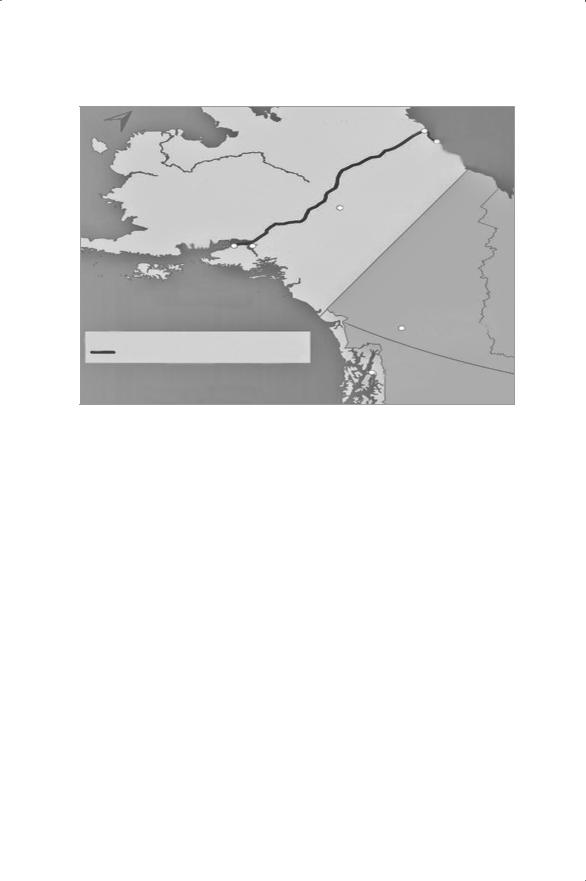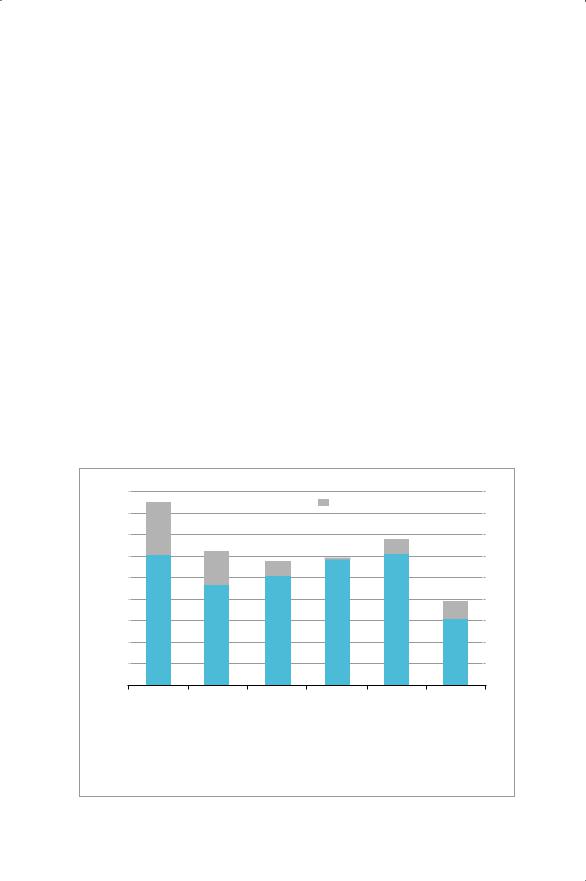
NPAC 2014 Proceedings_final
.pdf
74 |
Patterns of Arctic Investment |
far, it has announced two agreements: a 3-mmtpa contract with CNPC, and a 2.5 mmtpa with Spain’s Gas Natural Fenosa (GNF). The remaining 11 mmtpa should look for other takers.
Novatek has estimated the total cost for CAPEX for Yamal LNG development to be 20 billion, and it is argued that the project possesses price competitiveness against U.S. shale gas LNG. But according to Wood Mackenzie (2013),3 taking the challenging development conditions into consideration, the facility development cost is estimated to be 37 billion USD (gas field development 6.8 billion USD, drilling 14 million USD per well, liquefaction plant installation and maintenance costs 30.8 billion USD). Also, an additional 27 billion USD (2013 base) is estimated for operations and management (upstream operation 1.80/boe, liquefaction plant maintenance 0.60/MMbtu, icebreaker 10/ton). Taking a few additional assumptions into consideration, the final FOB cost for Yamal LNG development is estimated by Wood Mackenzie (2013) to be 9.41 USD/MMBtu. The regasification cost and transportation cost (nuclear icebreaker, ARC7 LNG transportation, storage cost) are not included in the final FOB LNG export costs.
With the advancement of multiple LNG projects around the world, development costs have increased rapidly, up to 1,200 USD/tonne, due to soaring raw material costs, lack of human resources and delayed construction. And most LNG projects have 20-60% in additional costs after they begin, while also being delayed for four to 17 months. Taking this situation into consideration, it is expected that the U.S. Henry Hub price level, crude oil price and Arctic area development costs will become the key to the competitiveness between all LNG projects, including those in the Arctic.
Progress of the U.S. Alaska LNG Project
Alaska’s State Assembly agreed to the state government’s participation in the Alaska LNG project on April 21, 2014. The state government is planning to conclude a contract with ExxonMobil, BP, Conoco Philips and TransCanada for the export of North Slope natural gas.
The Alaska LNG project includes connecting 800 miles (about 1,287 km) of export pipelines from the North Slope gas production sites (Prudhoe Bay, Point Thompson, etc.) to gas export terminals in the southern shore of Nikiski, along with the construction of liquefaction plants, storage facilities and export terminals. The total cost is estimated to be 45-65 billion USD.4

Commentaries |
75 |
N
A L A S K A
Nikiski Anchorage
Gulfof Alaska
KEY
Possible LNG pipeline project route
Paci c Ocean
Figure I-6. The Alaska LNG project
Prudhoe Bay |
Beaufort Sea |
|
|
|
Point |
|
Thomson |
Fairbanks |
|
YUKON
Whitehorse
Juneau
With the approval of the state assembly, the related companies have entered the FEED phase with the state government and are expected to export natural gases from the North Slope into Asia and Europe starting from the mid-2020s.5
The Alaska LNG project holds promise for Asian countries, as it is a lot closer for them than Russia’s Arctic, Western Canada, or the U.S. Gulf of Mexico. However, as of today, whether the long-term contract options can meet the demand of Asian consumers, as well as how large the possible amount of gas supply stock will be, is hard to know. But considering its location, it seems to be the closest Arctic LNG project for Northeast Asian consumers.
IMPLICATIONS FOR ASIAN BUYERS
Opening of Arctic Sea Route and South Korea’s Gas Consumption
Pattern
South Korea will likely participate in the Yamal LNG project if the nation

76 |
Patterns of Arctic Investment |
is willing to join any Arctic project.6 However, Russia is employing a strategy of simply allowing shareholding or securing offtakers from South Korean and other Asian companies.
According to South Korea’s long-term supply outlook for natural gas, the supply and demand situation is not as tight either. Especially with the introduction of American Sabine Pass gas in 2017, new options are opening up. Therefore, as a gas consumer, South Korea is not experiencing urgency in securing Russia’s gas exports. Also, given the recent progress regarding China-Russia gas contracts, it is noted that a South-North-Russia gas pipeline project is at a wait-and-see level.
An important fact about South Korea’s gas consumption pattern is that it shows a typical high-winter and low-summer consumption rate. This sort of pattern does not fit well with the conditions of the Arctic Northern Sea Route, which opens up for about four months during the summer. Therefore, if South Korea wishes to become an offtaker of Yamal LNG, it is important to consider the contractual flexibility of swapping unnecessary gas at will along with the price conditions. South Korea, along with Japan and other consumers around Asia, is trying hard to come out of an oil-indexed scheme. And the Yamal LNG Project is focused on securing additional offtakers. Whether or not KOGAS participates in the project will depend upon the conditions of negotiation.
6,000,000 |
|
|
|
|
|
|
|
|
|
|
|
|
|
|
|
|
|
|
|
|
|
|
|
(Unit: ton) |
|||
|
|
|
|
|
|
|
|
|
|
|
|
|
|
|
|
|
|
|
|
|
|
|
|
|
|
|
|
5,000,000 |
|
|
|
|
|
|
|
|
|
|
|
|
|
|
|
|
|
|
|
|
|
|
|
|
|
|
|
4,000,000 |
|
|
|
|
|
|
|
|
|
|
|
|
|
|
|
|
|
|
|
|
|
|
|
|
|
|
|
|
|
|
|
|
|
|
|
|
|
|
|
|
|
|
|
|
|
|
|
|
|
|
|
|
|
|
|
3,000,000 |
|
|
|
|
|
|
|
|
|
|
|
|
|
|
|
|
|
|
|
|
|
|
|
|
|
|
|
|
|
|
|
|
|
|
|
|
|
|
|
|
|
|
|
|
|
|
|
|
|
|
|
|
|
|
|
2,000,000 |
|
|
|
|
|
|
|
|
|
|
|
|
|
|
|
|
|
|
|
|
|
|
|
|
|
|
|
|
|
|
|
|
|
|
|
|
|
|
|
|
|
|
|
|
|
|
|
|
|
|
|
|
|
|
|
1,000,000 |
|
|
|
|
|
|
|
|
|
|
|
|
|
|
|
|
|
|
|
|
|
|
|
|
|
|
|
|
|
|
|
|
|
|
|
|
|
|
|
|
|
|
|
|
|
|
|
|
|
|
|
|
|
|
|
|
|
|
|
|
|
|
|
|
|
|
|
|
|
|
|
|
|
|
|
|
|
|
|
|
|
|
|
|
|
|
|
|
|
|
|
|
|
|
|
|
|
|
|
|
|
|
|
|
|
|
|
|
|
|
|
- |
|
|
|
|
|
|
|
|
|
|
|
|
|
|
|
|
|
|
|
|
|
|
|
|
|
|
|
|
Jan. Feb. Mar. Apr. May Jun. |
|
Jul. Aug. Sept. Oct. Nov. Dec. |
||||||||||||||||||||||||
|
|
|
|||||||||||||||||||||||||
|
|
|
|
|
|
|
|
|
|
Generation |
|
City gas |
|||||||||||||||
|
|
|
|
|
|
|
|
|
|
||||||||||||||||||
|
|
|
|
|
|
|
|
|
|
||||||||||||||||||
source: KOGAS |
|
|
|
|
|
|
|
|
|
|
|
|
|
||||||||||||||
Figure I-7. Korea’s gas consumption by month (2013)

Commentaries |
77 |
Cost of LNG Based on East Asian Destinations (LNG Delivered ExShip Cost)
The picture below compares the destination costs of LNG from several locations with South Korea’s Port of Incheon set as the common destination. With Incheon as the standard, it is not hard to estimate the cost for China’s and Japan’s key LNG ports as well.
The competitive levels between LNG projects around each region of the world are based on a long-term LNG price formula. As of now, regarding the recent crude oil price and Henry Hub standard, the Henry Hub-indexed price formula is likely to ensure better price competitiveness than an oilindexed price formula.
The key points for competitiveness for North American projects depend upon the gas market price level, while the new projects in the Arctic and East Africa will be based on development costs. Asian nations will continue to make efforts to come out of an oil-indexed scheme and lower the contract price. But considering the new LNG supply costs, the portion of contracts with oil-indexation will remain high for long time.
18
Range across projects
16
14 |
4.6 |
|
|
|
0.7 |
|
|
12 |
|
|
|
0.1 |
|
|
|
|
3.0 |
1.3 |
|
|
|
||
10 |
|
|
|
|
|
||
|
|
|
|
|
|
|
|
8 |
12.3 |
|
|
|
|
|
1.6 |
6 |
|
10.2 |
11.8 |
12.3 |
|
||
|
|
|
|
||||
|
9.4 |
|
|
|
|||
4 |
|
|
|
|
|
|
|
|
|
|
|
|
|
6.2 |
|
2 |
|
|
|
|
|
|
|
0 |
Australia |
Russia |
EastAfrica |
US GoM* |
West Canada** |
Southeast |
|
|
Asia |
||||||
|
* HH US$5.5/MMBtu |
** Netback from HH + Popeline Cost |
|
|
|||
Source: Wood Mackenzie, LNG Tool
Figure I-8. LNG DES cost stacks to Incheon ($MMBtu)

78 |
Patterns of Arctic Investment |
South Korea, Japan, Taiwan, and other key Asian LNG importers are working side by side to reduce the Asia gas premium, reform the destination clause and secure flexibility within contract options. LNG suppliers who are desperately willing to accept these conditions will be a key factor moving toward ensuring offtakers for the new projects.
Notes
1.USGS 2008 Data.
2.As of 2014, 70-80% of the world’s LNG consumption is in the Asia-Pacific region, and this trend is likely to continue.
3.Wood Mac, LNG Supply Analysis, Russia, April 2013.
4.The Alaska LNG project transports 3-3.5 Bcm/d of natural gas to a liquefaction plant through a 42-inch pipeline, and the liquefaction plant produces 15-18 million tons (2~2.4Bcf/d) of LNG every year.
5.Alaska began exporting LNG in the 1960s, and its main gas source is located south of Anchorage at Cook Inlet.
6.South Korea’s KOGAS took some stakes in Northern Canada’s Umiak gas field in the Artic in 2011.

Commentaries |
79 |
Commentary
Heather A. Conley
When we read about the Arctic in the print media, we are greeted by sensational and typically inaccurate headlines such as “A New Cold War!,” “A Race for Arctic Riches!,” and “Arctic Bonanza!” Rare is the factual headline, much less detailed information, about the overall political, economic, and security trend lines in the Arctic region. Arctic analysts and experts must perpetually employ “myth-busting” analysis to temper wild assumptions about Arctic developments.
Thankfully, three thoughtful authors provide rich and detailed descriptions of two important Arctic investment patterns: “Arctic Offshore Petroleum and Shipping” from Arild Moe and Svein Vigeland Rottem of the Fridtjof Nansen Institute in Norway, and from Valeriy A. Kryukov, “Patterns of Investment in the Russian Onshore Arctic–An Area of Stable Growth? The level of detail related to both the scope and scale of significant Arctic development projects provides a concrete understanding of what is at stake for both the sovereign and commercial actors involved.
To understand the region with the greatest level of economic ambition and potential dynamism, one must begin in the Russian Arctic. Kryukov notes that for Russia, the Arctic is “the most important component of socioeconomic development as a whole,” a fact that the international community wholly underappreciates, as well as the “historical significance of Russian northern development.” This concept bears repeating: the international community profoundly underestimates the forces influencing Russia’s and ultimately President Putin’s future for a region that encompasses nearly the entire northern coast of Eurasia. The Arctic is home to Russia’s strategic nuclear fleet, 14% of Russia’s GDP, 25% of its exports, 50% of the total Arctic coastline, and two million Russian citizens, thus making the Arctic a key driver of Russian policy in the 21st century. Dmitry Medvedev noted in 2008 that “Our first and main task is to turn the Arctic into a resource base for Russia in the 21st century … Using these resources will guarantee energy security for Russia as a whole.”1 As former Murmansk Oblast Governor Dmitri Dmitriyenko further underscored, “For Murmansk Oblast, the election of Vladimir Putin as President of the Russian Federation is a very important event, which means the continuity

80 |
Patterns of Arctic Investment |
of the current course … a course of huge breakthrough projects, which gradually will transform the social and economic situation in the region. Probably, Putin is the only of our politicians who knows and understands the Russian Arctic, and who underlines that it is in the Arctic that Russia has its future.” With such an emphasis on the importance of the Arctic for Russia’s future, the economic and political stakes for Russia are enormously high.
Kryukov provides an important analytical framework to examine the plethora of new Russian development projects, ranging from the excavation of mineral resources, such as phosphate, nickel, platinum, diamonds, and gold, to the extraction of energy resources such as coal, oil, and natural gas. The analytical framework consists of: (1) the need for extensive capital investment; (2) the introduction of new technology; (3) the technological difficulty of reaching these resources; and (4) the resources exceed Russian domestic demand and are produced for export. Helpfully, he geographically breaks the Russian Arctic into three strategic and quite different regions of development: European Russia, Siberia, and the Russian Far East. Kryukov contends that all Russian onshore activities–regardless of location– require two things: (1) significant technology, as well as technical skills enhancements, and (2) modernization.
After the annexation of Crimea and the destabilization of Eastern Ukraine, technology transfer from the West to Russia will be interrupted by enhanced Western sanctions. Modernization, defined by adaptation to the mechanisms of the global economy, would require domestic political and economic reforms that fuel entrepreneurship and foreign investment and legal reforms that create an independent judiciary and ensure transparency. Modernization would also require a less-centralized Russia (it is more centralized than ever) and a better investment climate, bolstered by improvements to the rule of law, management, and social and environmental concerns. These elements do not exist in Russia today, posing significant obstacles to successful Russian modernization.
Kryukov offers two contradictory Russian Arctic investment trends: general stagnation in the Russian mining sector and growth potential in the oil and gas sector, with specific attention being given to the Yamal Peninsula liquefied natural gas (LNG) terminal and the Port of Sabetta. In the mining sector, stagnation has translated into a decline in industrial production and decreases in the mining sector workforce. From a socioeconomic standpoint, this stagnation has significant implications for the northern

Commentaries |
81 |
“monotowns” that are completely dependent on one industry. Norilsk Nickel, the world’s largest producer of refined nickel, is both an important example of static Russian investment and a shift in business practices. As a monopoly, whose “private” investor ownership consists of major Russian financial and industrial groups, and that has been slow to modernize and adapt to global economic forces, Norilsk Nickel accounts for 1.9% of Russia’s GDP and has its own Arctic fleet (seven ice-class cargo ships and one ice-class tanker). Norilsk Nickel is also one of Russia’s largest polluters, accounting for a quarter of Russia’s sulfur dioxide emissions. Norilsk Nickel, seeing the greatest growth potential in its polar division, recently reduced its mining operations in southern regions and eliminated Russian jobs. Now, contrast this with a newly formed Russian company, Russian Platinum LLC, which views environmental stewardship as a high priority and plans to construct its own infrastructure, not relying on use of the Northern Sea Route (NSR), but rather the Yenisei River to transport resources from the Norilsk-I field (Krasnyorsk Oblast).
While international attention tends to focus on the European and Siberian portions of the Russian Arctic, one must not forget the great mineral resources of the Russian Far East. Significant deposits of iron ore, rare earths, and impact diamonds in the Russian Far East’s (Yakutia) Tomtor field constitute one of the largest ore deposits in the world. As these resources are developed, the eastern portion of the NSR will likely be utilized to transport these riches to Asian and international markets, which could significantly increase shipping traffic in the Bering Strait over time.
While mineral extraction is stagnating in Russia, oil and gas projects are on the rise and are considered national “prestige projects.” Kryukov notes that these prestige projects are granted “state guarantees [to ensure that] even constant unprofitable businesses will survive.” Russian state guarantees have been ubiquitous following the 2008 definition of “subsoil plots of federal significance,” which narrowly defines a federally significant project as more than 70 million tons of discovered oil and 50 billion cubic meters of natural gas. Simply put, nearly every commercially viable mineral and natural resource discovery in Russia is deemed significant to the Kremlin. This new definition, however, has dramatically reduced new licenses. Clearly, increased Russian central control over mineral and energy resources, coupled with the requirement that Moscow must approve any sale of 10% or more to foreign entities and that foreign ownership of an investment project cannot exceed 51%, has substantially restricted the

82 |
Patterns of Arctic Investment |
forces of foreign investment and advanced technologies entering Russia today.
Why has the Kremlin enacted a stranglehold over new Arctic investment projects when decentralization and incentivizing international technology transfers are necessary for success? The answer is budget dependency. In 1995, oil and gas revenues accounted for 9% of the Russian budget. In 2012, oil revenues made up 52% of the Russian federal budget. Although global oil and commodity prices remain quite high (at the time of this writing, Brent oil was 104 USD per barrel), these prices are unable to sustain Russia’s ailing economy.2 Today, Russia finds itself in a completely new operational environment where its most important energy customer, Europe, has a rapidly decreasing appetite for Russian energy due to anemic economic growth, deteriorating demographics, the decreased price of natural gas (which has spurred contract renegotiation), anti-monopolistic rules, and increased use of renewable energy and energy efficiency. Moreover, Europe is currently racing to diversify itself away from Russian energy resources. In addition to Europe’s decreased demand, Russia is also facing increased global competition from other energy suppliers such as Australia, North America, and Africa.
The Russian gas market faces the dual challenge of rising costs (a 10% increase in 2013) and declining demand. This environment has forced Russian companies–Gazprom, Rosneft, and Novatek–to compete with each other while simultaneously competing for foreign direct investment (FDI) and Kremlin approval of their projects as they attempt to increase natural gas revenues. The Yamal LNG project appears to be the most competitive Russian Arctic gas project. In 2002, the Gazprom Board of Directors named the Yamal Peninsula a region of strategic interest. Rosneft’s CEO Igor Sechin, a close confidant of President Putin, has for now successfully concentrated Rosneft’s power and influence in the Russian gas market and Arctic energy development, thus ensuring its geopolitical relevance.
For the Russian oil market as well, regulating controls will be as important as reform of the Russian tax system. While it may be true that the Russian government will continuously sustain unprofitable businesses, international companies will not. The long-term development of new Russian oil fields is not economically competitive under the current Russian tax regime, although tax exemptions have been granted for Arctic development. Due to the over-reliance of the Russian budget on rent income from the oil and gas sector, Russian authorities are extremely

Commentaries |
83 |
reluctant to reform the tax code, as it would entail great political risk to Russian authorities.
After taking a deep dive into Russian Arctic development, Arild Moe and Svein Rottem take us on an Arctic offshore circumpolar journey which can best be described as “the unevenness of Arctic development.” While Arctic offshore activities are at present limited to two fields in Norway and Russia, Canada is exploring limited, private-led opportunities in the Beaufort Sea. The United States is slowly exploring its offshore potential in the Chukchi and Beaufort Seas, and Greenland, while initially exploring opportunities, has found mostly gas (and not necessarily commercially viable amounts) but seeks oil deposits. Having recently identified potential rare earth minerals in Greenland, there may be greater economic benefits from mining than from energy discoveries.
Norway and Russia demonstrate some similarities in offshore Arctic development. State companies are the principal conduit for development, and both countries rely on energy exports to support their national economies. For Norway, Arctic development has taken on some urgency as declining productivity in the North and Norwegian Seas has required exploration further north, with a particular focus on the 12 billion USD Snøhvit field. Like Russia’s federal significance determination, the Norwegian government conducts “opening processes” in which it formally assesses the risks and prospects of exploration in a particular area. Moreover, the Norwegian government is also responsible for issuing exploration licenses to oil and gas companies. Several areas of the offshore Norwegian shelf, including all of the northern Barents Sea, the eastern part of the southern Barents Sea, and the northeastern Norwegian Sea, have not been approved for petroleum activities due to limited knowledge of seismic activity in the region. However, the Norwegian government will offer 34 licensing blocks in the Barents Sea before the end of 2014, increasingly moving into areas further north and east. The Norwegian government is also grappling with its Arctic infrastructure. Should it export its Arctic energy via pipeline or LNG tanker? The choice of infrastructure is based largely on the choice of market. Does Norway seek to export its Arctic offshore resources to Asia (a 2013 LNG condensate tanker departed Hammerfest, Norway for Tokyo, Japan) or could Norwegian gas one day displace Russian gas exports to Europe? In 2012, Norwegian gas exports to Europe exceeded Russian exports, but in 2013 Russia once again became the leading exporter of gas to Europe.
